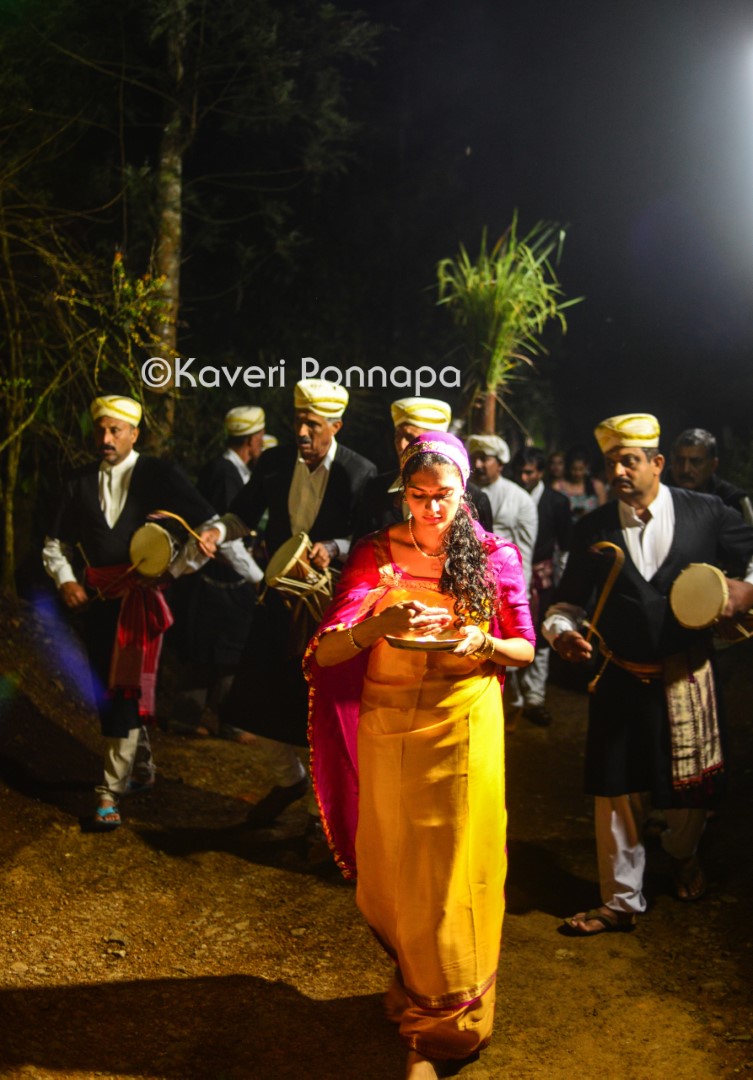
Led by a young woman bearing the taliyatakkibolcha (bell metal platter heaped with rice on which a lit lamp is placed) the dudipatkaras, once again, sing batte pat (song of the path) as the harvest procession winds its way to the kaimada (small ancestor shrine), where a cluster of freshly harvested grain wrapped in special leaves and creepers is tied. These clusters of grain are also offered at a choundi shrine (protective land spirit), and other smaller shrines along the path. The procession converges at the local shrine dedicated to the goddess Bhagavathi, which also has within its enclosure, as shrine dedicated to Botekara Aiyappa, the ancient Kodava God of the Hunt. All the kade (harvested grain) is placed at the entrance of the temple, and soon, the neighbouring Kandanda okka (patrilineal descent group) comes in a similar procession, bearing freshly harvested grain from their own rice fields. Kade is offered to the gods, and the takkas (spokespersons) of the respective okkas make formal speeches. A short ceremony is performed by the priest of the shrine, who offers tirtha (scared water) to the assembled people.

The men dance three rounds of bolkaat around the temple premises, before they leave, once again in procession, singing batte pat, to their respective ain manes (ancestral homes). The Kundyolanda ain mane does not have a kall boti (ceremonial stone pillar) in its front yard, where rituals related to rice cultivation and harvest are generally conducted. Instead, a temporary wooden pillar is set up half-way to the ain mane, and the procession walks around a circle marked out around it in rice powder three times, demonstrating one of the many minor variations in customs around Kodagu.

At the ain mane, the procession is greeted with fireworks and bursting of crackers to welcome the harvest. The kuthi kara (bearer of the harvest receptacle) has his feet washed with water, and is offered milk to drink before he enters the house. The harvested grain is laid at the tookbolcha (hanging lamp), and kade tied at all the auspicious locations in the house, such as the kanni kombare (scared chamber for ancestor worship) and nellakki nadubade (scared central hall).


Seated on the kitchen floor, the kuthi kara kneads rice flour, and ripe bananas into a sticky dough, small portions of which are placed on ashwatha (peepul) leaves, about 100 portions. Every member of the clan is given a leaf to throw up at the ceiling, and offering to the ancestors and dead of the okka. The senior woman of the okka who has been given the task of decorating spaces with rice flour stencils throws the first leaf, repeating this at each location that is marked by a rice stencil decoration. A community dinner is served, while the dudipatkaras sing the mane pat (history of the family) through the night. This practice has is now slightly altered, and the song is begun the next morning, and sung until the okka gathers at the mand (open community space) in the late afternoon to dance the puthari kol (harvest dance).
The living puthari traditions described above were documented on 7 th December, 2022 at the Kundyolanda ain mane.

